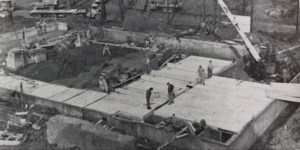While most of us are familiar with the different buildings around campus, very few are aware of the history that makes up the places on campus we see every day.
Salzman Stadium

Early picture of Salzman Stadium. Photo provided by the Bluffton University Archives
Salzman Stadium was dedicated on Sept. 11, 1993. It was named after Dwight Salzman, who graduated from Bluffton College in 1926. He, along with his wife Hazel, donated $250 thousand toward the stadium, according to the dedication program. Salzman majored in biology. He was a member of Bluffton College’s first track team, where his best events were the 440 and half-mile. He was also a fullback for the football team. Salzman was also involved in helping create the Bluffton College Sports Hall of Fame in 1974.
The stadium allowed Bluffton’s football team to play on campus for the first time in the 75 years of the program. The original project included a 2,100-seat closed aluminum and steel stadium, 500-seat bleachers for opponent fans, 66-foot press box, 138-foot-wide pavilion with team rooms, showers, officials’ rooms, restrooms, a concession stand, three second-floor classroom and storage space. Then, President Elmer Neufeld estimated the total project, including stadium construction and lines for the sewer, water, electricity and gas, to be $700 thousand.
One infamous story about the new stadium is the press box not arriving until less than a week before Bluffton’s first game against Ohio Northern University.
According to a 1992 edition of The Scope, when asked about this, Coach Carlin Carpenter was known for saying, “Are the ONU buses in the parking lot? Then quit worrying.” Although the Beavers lost their first game to ONU, over 500 people filled the stadium.
Emery E. Sears Athletic Complex

Aerial view of Emery E. Sears. Photo provided by the Bluffton University Archives
The Emery E. Sears Athletic Complex includes the baseball diamond, soccer and football fields, and track. Dedicated in the fall of 1986, the complex is named after the man who donated $100 thousand towards the construction of the complex. Sears graduated from Bluffton College in 1928 after majoring in biological sciences. He lettered in football, basketball and track while at Bluffton, and he got elected to the Bluffton College Athletic Hall of Fame in 1975. He frequented the dean’s list and was the vice president of the senior class.
According to the Opening Celebration program, the complex was constructed in two parts. Phase one included providing drainage for the 13-acre field, a temporary asphalt surface on the track and minimal baseball facilities. Phase two consisted of an all-weather Zemco rubberized track surface, fencing around the entire complex and facilities for the field events. The ceremonial ribbon cutting was performed by Sears and A.C. Burcky.
Ramseyer Hall

Early picture of Ramseyer Hall. Photo provided by the Bluffton University Archives
Ramseyer Hall, opened in Sept. 1994, was named after Lloyd L. Ramseyer, the longest-tenured president of Bluffton College at 27 years. He played football, participated in debate, Glee Club, Vesper Choir and Choral Society, and he served as manager of the Ista and The Witmarsum in his time at Bluffton. He graduated from Bluffton College in 1924 and worked as a coach, teacher and principal after graduating, before coming back to Bluffton in 1938 as a biology teacher. He began his presidency the same year.
According to an old copy of The Witmarsum, a student described the new dorm as being “like a hotel room” because of its amenities, including an exercise room, air conditioning, and automatically locking doors that required a magnetic card to enter. Ramseyer was the first co-ed dorm, with women on the bottom two floors and men on the third floor.
The dorm was built to house more students due to growing enrollment. When it opened, Bluffton housed 630 residential students, 111 of them living in Ramseyer.
Quoted in a copy of The Scope, Don Schweingruber, vice president of student affairs, said, “Constructing Ramseyer is a clear statement that we value the residential experience at BC and believe that it is an integral part of our education programs.”
Moisman Hall

Construction for Moisman. Photo provided by the Bluffton University Archives
Moisman Hall was named after S.K. Mosiman, the president of Bluffton College for 25 years. It was dedicated on Oct. 23, 1960. Under his presidency, Moisman was an advocate for the growth and development of a strong music program. He even drew a proposed structure for a music building over 30 years before the actual proposal, although his ideas were not used in the actual proposal.






